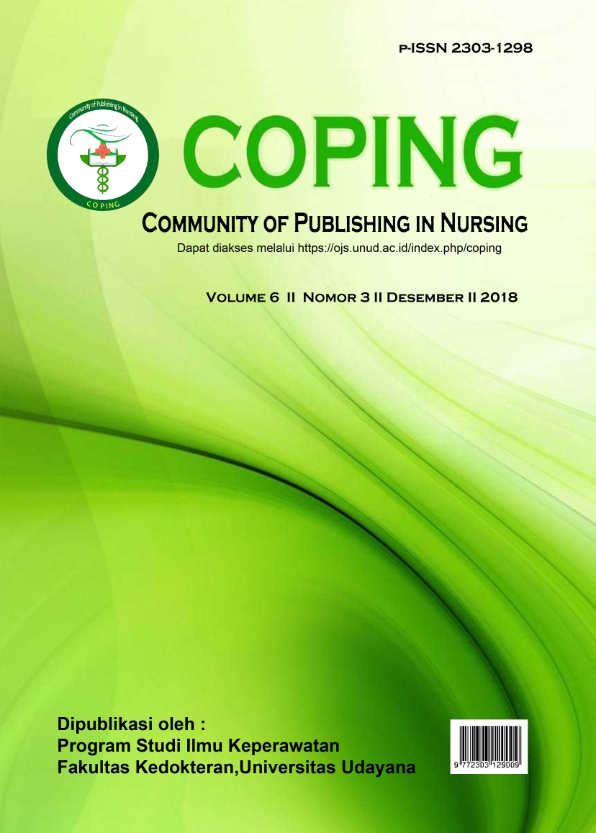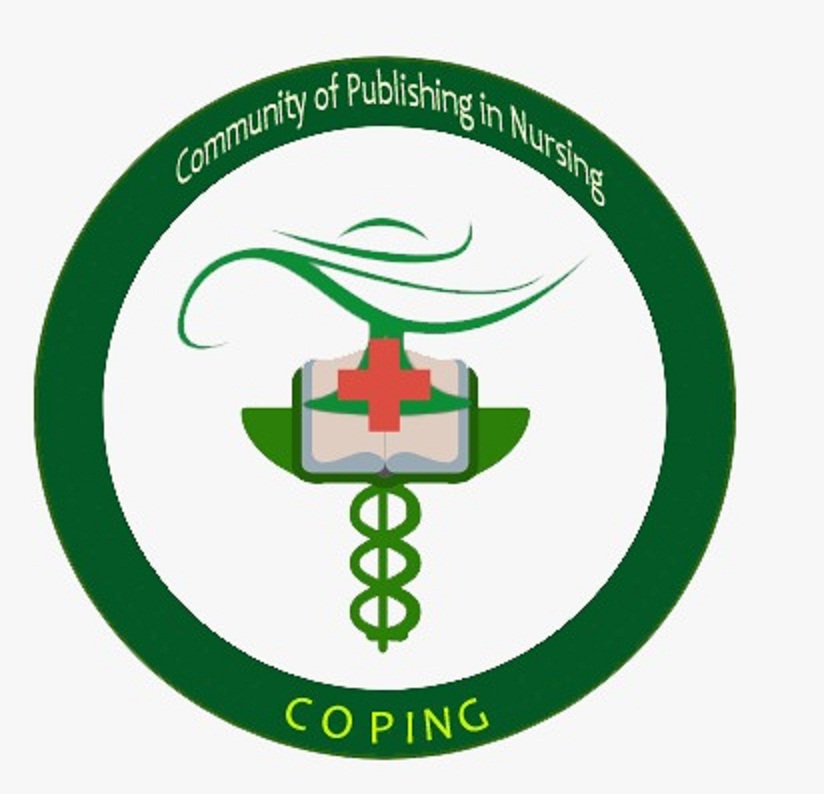PENGARUH EDUKASI DUA LINTAS TERHADAP JUMLAH, JENIS, DAN JADWAL MAKAN PENDERITA DM TIPE 2
Abstract
Kontrol glikemik yang buruk pada orang dengan DMT2 ditunjukkan dengan perilaku makan yang tidak sehat. Itu berarti orang dengan T2DM masih membutuhkan pengobatan untuk meningkatkan kontrol glikemik. Pendidikan dua arah adalah salah satu pendidikan yang mengandung pendidikan gizi dan penyelesaian masalah yang meningkatkan pengetahuan dan melibatkan orang-orang dengan T2DM secara aktif dalam proses pendidikan. Tujuan dari penelitian ini adalah untuk mengetahui pengaruh pendidikan dua arah terhadap jumlah, jenis, dan jadwal makan penderita T2DM. Penelitian ini adalah eksperimen quasy yang menggunakan Nonequivalent Control Group Design. Jumlah sampel dalam penelitian ini adalah 30 orang yang 15 orang di setiap kelompok yang dipilih dengan metode Purposive Sampling. Penelitian ini menggunakan EFR 3x24 jam sebagai instrumen untuk pretest dan posttest. Pretest-posttest menunjukkan jumlah (p = 0,008) dan jadwal (0,000) makan pada kelompok intervensi berbeda secara signifikan. Hasil penelitian ini juga menunjukkan ada pengaruh pendidikan dua arah terhadap jumlah (p = 0,001) dan waktu (p = 0,038) orang yang makan T2DM di Wilayah Kerja Puskesmas II Denpasar Barat. Dua cara pendidikan perlu disampaikan kepada orang-orang dengan T2DM untuk meningkatkan pengetahuan dan pemecahan masalah.
Kata kunci: DM tipe 2, pendidikan dua arah, jumlah, tipe, dan jadwal makan
ABSTRACT
Bad glycemic control in people with T2DM shown with unhealthy eating behavior. It mean people with T2DM still need treatment to improve glycemic control. Two ways education is one of education which contain nutrition education and problem solving that improve knowledge and involve people with T2DM actively in education process. Aim of this study is to determine the effect of two ways education on amount, type, and schedule of eating people with T2DM. This study is a quasy experiment which use Nonequivalent Control Group Design. Number of sample in this study is 30 peoples which 15 peoples in each group which selected with Purposive Sampling method. This study use EFR 3x24 hours as instrument for pretest and posttest. Pretest-posttest showed amount (p=0,008) and schedule (0,000) of eating in intervention group was significantly different. This study result also showed there is effect of two ways education on amount (p=0,001) and time (p=0,038) of eating people with T2DM at Puskesmas II West Denpasar Working Area. Two ways education needs to be delivered to people with T2DM to improve knowledge and problem solving.
Keywords: type 2 DM, two ways education, amount, type, and schedule of eating
Downloads
References
Cheng, A. Y. Y. (2013). Introduction dalam Canadian Journal of Diabetes 37 S1-S3
Depkes. (2013). Riset Kesehatan Dasar 2013, (online), (http://www.litbang.depkes.go.id/sites/download/rkd2013/Laporan_Riskesdas2013.PDF diakses pada tanggal 18 Oktober 2014)
Dirdaloo, A., Shojaeizadeh, D., Gharaaghaji, R., Niknami, S., dan Khorami, A., (2014). Psychosocial Correlates of Dietary Behaviour in Type 2 Diabetic Women, Using a Behaviour Change Theorydalam JHPN 32(2) p:335-341
Dizaji, M. B., et al. (2014). Effect of Educational Intervention Based on PRECEDE Model on Self Care Behaviors and Control in Patients with Type 2 Diabetes in 2012 dalam Journal of Diabetes & Metabolic Disorders 13:72
Ganiyu, A. B., Mabuza, L. H., Malete, N. H., Govender, I., dan Ogunbanjo, G. A., (2013). Non-adherence to Diet and Exercise Recommendations Amongst Patients with Type 2 Diabetes Mellitus Attending Extension II Clinic in Botswana dalam Afr J Prm Health Care Fam Med 5(1)
Glasgow, R. E., Fisher, L., Skaff, M., Mullan, J., dan Toobert, D. J., (2007). Problem Solving and Diabetes Self-Management dalam Diabetest Care Vol. 30(1)
Goldenberg, R. dan Punthakee, Z. (2013). Definition, Classification and Diagnosis of Diabetes, Prediabetes and Metabolic Syndrome dalamCanadian Journal of Diabetes 37 S8-S11
Graves, C. J., Reddy, P., dan Sheppard, K., (2010). Supporting Behaviur Change for Diabetes Prevention dalam Diabetes Prevention in Practice 19-29
Heriansyah. (2014). Pengaruh Edukasi dengan Pendekatan Prinsip Diabetes Self Management Education (DMSE) Dalam Meningkatkan Pengetahuan Diet terhadap Kepatuhan Diet pada Penderita Diabetes Mellitus Tipe 2 dalam Jurnal Ilmiah Kesehatan Diagnosis Vol. 4
Hill-Briggs, F., et al. (2011). Effect of Problem-Solving-Based Diabetes Self-Management Training on Diabetes Control in a Low Income Patient Sample dalam Journal General Internal Medicine 26(9):972-8
IDF. (2013). IDF Diabetes Atlas Sixth Edition, (online), (www.idf.org/diabetesatlas, diakses pada tanggal 16 Oktober 2014)
Jones, H., Berard, L. D., MacNeill, G., Whitham, D., dan Yu, C. (2013). Self-Management Education dalam Canadian Journal of Diabetes 37 S26-S30
King, K. D., et al. (2010). Self-Efficacy, Problem Solving, and Social-Environmental Support are Associated With Diabetes Self-Management Behaviors dalam Diabetes Care Volume 33 (4)
Livana, P. H., Sari, I. P., & Hermanto, H. (2019). Gambaran Tingkat Depresipasien Diabetes Mellitus di Kabupaten Kendal. Jurnal Kesehatan Poltekkes Ternate, 11(2), 48-57.
Livana, P. H., & Sari, I. P. (2019). Description of the Level of Ansietas of Patients of Diabetes Mellitusin Kendal District. International Journal of Diabetes and Endocrinology, 4(2), 57.
Livana, P. H., Sari, I. P., & Hermanto, H. (2018). GAMBARAN TINGKAT STRES PASIEN DIABETES MELLITUS. Jurnal Perawat Indonesia, 2(1), 41-50.
Malek, M. dan Cakiroglu, F. P., (2013). The Effects of Nutritional Education on Patients with Type–II Diabetes on the Nutritional Knowledge and Consumption dalam European Journal of Experimental Biology 3(1): 217-222
Morris, J., Marzano, M., Dandy., dan O’Brien, L., (2012). Therorise and Models of Behaviour and Behaviour Change.Forest Research.
Muchiri, J. W., (2013). Development and Evaluation of a Nutrition Education Programme for Adults with Type 2 Diabetes Mellitus in Resource Limited Setting of the Moretele Sub-District, North West Province (South Africa). Thesis tidak diterbitkan.Pretoria Faculty of Health Sciences University of Pretoria.
Notoatmodjo, S. (2007).Promosi Kesehatan dan Ilmu Perilaku. Jakarta: Rineka Cipta
Novo Nordisk. (2013). Changing diabetes in Indonesia, (online), (http://www.novonordisk.com/images/Sustainability/PDFs/Blueprint-for-change-Indonesia--52383_Korr19.pdf diakses pada tanggal 19 Oktober 2014)
Om, P., Deenan, A., dan Pathumarak, N., (2013). Factors Influencing Eating Behavior of People with Type 2 Diabetes in Bhutan dalam Journal of Science, Technology, and Humanities Vol. 11 No. 2 p:129-138
Perkeni. (2011). Konsensus Pengendalian dan Pencegahan Diabetes Mellitus Tipe 2 di Indonesia. Jakarta: PB. Perkeni
Phitri, H., E., dan Widiyaningsih. (2013). Hubungan Antara Pengetahuan dan Sikap Penderita Diabetes Mellitus dengan Kepatuhan Diet Diabetes Mellitus di RSUD AM. Parikesit Kalimantan Timur dalam Jurnal Keperawatan Medikal Bedah Vol. 1.
Primanda, Y., Kritpracha, C., dan Thaniwattananon, P., (2011). Dietary Behaviors among Patients with Type 2 Diabetes Mellitus in Yogyakarta, Indonesia dalam Nurse Media Journal of Nursing (1): 211-223
Robbins, J. M., Thatcher, G. E., Webb, D. A., dan Valdmanis, V. G., (2008). Nutitionist Visits, Diabetes Classes, and Hospitalitation Rates and Charges dalam Diabetes Care Vol. 31(4)
Smeltzer, S. C., Bare, B. G., Hinkle, J. L., & Cheever, K. H. (2014). Brunner and Suddarth’s Textbook of Medical-Surgical Nursing13th edition. Philadelphia: Lippincott William & Wilkins.
Sunaryo dan Haryati, W., (2007). Perbandingan Pendidikan Kesehatan Antara Metode Diskusi dan Pemecaha Masalah Dalam Perubahan Perilaku Pasien Diabetes Mellitus Tipe 2 di RSUD Swadana Pekalongan dalam Jurnal Keperawatan Soedirman Vol. 2(1)
Todd, R. M., Britton, M. L., dan Harrison, D. (2011). Identification of Barriers to Appropriate Dietary Behaviours in Low-Income Patients with Type 2 Diabetes Mellitus dalam Diabetes Ther 2(1):9-19
Tol, A., Mohebbi, B., dan Sadeghi, R., (2014). Evaluation of dietary habits and related factors among type 2 diabetic patients: An innovative study in Iran, (online), (diakses melalui http://www.ncbi.nlm.nih.gov/pmc/articles/PMC3977396/pada tanggal 7 Desember 2014)







